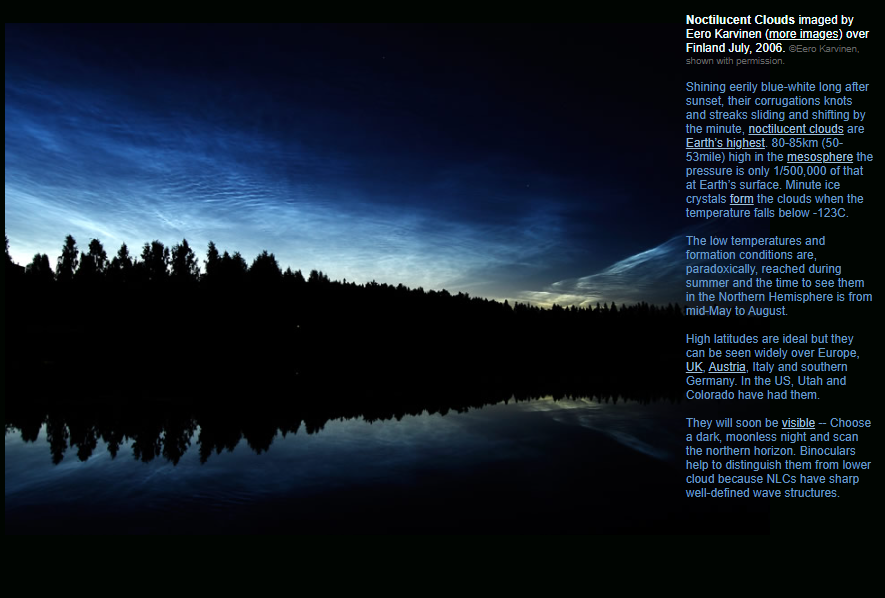Highest Clouds
Highest Clouds: Noctilucent Clouds
Noctilucent clouds, also known as NLCs, are a captivating atmospheric phenomenon that can be observed in the night sky. These ethereal clouds shine with an eerie blue-white glow long after sunset, creating a mesmerizing display. What makes them even more intriguing is the fact that they are Earth's highest clouds, located in the mesosphere at an astonishing altitude of 80-85 kilometers (50-53 miles) above the Earth's surface.
In the mesosphere, the pressure is incredibly low, measuring only about 1/500,000 of that at the Earth's surface. The formation of noctilucent clouds occurs when minute ice crystals form due to extremely low temperatures. These temperatures can plummet to below -123 degrees Celsius (-189 degrees Fahrenheit), providing the ideal conditions for the formation of these high-altitude clouds.
Contrary to what one might expect, the best time to witness the beauty of noctilucent clouds in the Northern Hemisphere is during the summer months, from mid-May to August. This peculiar timing is due to the specific temperature and atmospheric conditions required for their formation. It is during this period that the mesosphere reaches the necessary low temperatures to create these stunning cloud formations.
While high latitudes are considered ideal for observing noctilucent clouds, they can be seen in various locations across Europe, including the United Kingdom, Austria, Italy, and southern Germany. In the United States, states such as Utah and Colorado have also been fortunate enough to witness these extraordinary clouds.
If you're eager to catch a glimpse of noctilucent clouds, there are a few key factors to consider. Firstly, choose a dark, moonless night for optimal visibility. This will enhance your chances of spotting these elusive clouds against the darkened backdrop of the night sky. Secondly, direct your gaze towards the northern horizon, as this is where noctilucent clouds tend to appear. Binoculars can be a useful tool in distinguishing them from lower clouds, as NLCs often exhibit well-defined wave structures that set them apart.
In conclusion, noctilucent clouds are a truly remarkable atmospheric phenomenon that grace the highest reaches of our atmosphere. Their ethereal beauty and mysterious nature make them a captivating sight for those fortunate enough to witness them. By understanding the optimal conditions and locations for observing noctilucent clouds, you can increase your chances of experiencing this awe-inspiring spectacle firsthand. So, keep an eye on the summer night sky and be prepared to be amazed by the highest clouds that Earth has to offer.

Noctilucent Clouds imaged by Eero Karvinen (more images) over Finland July, 2006. ©Eero Karvinen, shown with permission.
Shining eerily blue-white long after sunset, their corrugations knots and streaks sliding and shifting by the minute, noctilucent clouds are Earth’s highest. 80-85km (50-53mile) high in the mesosphere the pressure is only 1/500,000 of that at Earth’s surface. Minute ice crystals form the clouds when the temperature falls below -123C.
The low temperatures and formation conditions are, paradoxically, reached during summer and the time to see them in the Northern Hemisphere is from mid-May to August.
High latitudes are ideal but they can be seen widely over Europe, UK, Austria, Italy and southern Germany. In the US, Utah and Colorado have had them.
They will soon be visible -- Choose a dark, moonless night and scan the northern horizon. Binoculars help to distinguish them from lower cloud because NLCs have sharp well-defined wave structures.
Note: this article has been automatically converted from the old site and may not appear as intended. You can find the original article here.
Reference Atmospheric Optics
If you use any of the definitions, information, or data presented on Atmospheric Optics, please copy the link or reference below to properly credit us as the reference source. Thank you!
-
<a href="https://atoptics.co.uk/blog/highest-clouds/">Highest Clouds</a>
-
"Highest Clouds". Atmospheric Optics. Accessed on November 26, 2024. https://atoptics.co.uk/blog/highest-clouds/.
-
"Highest Clouds". Atmospheric Optics, https://atoptics.co.uk/blog/highest-clouds/. Accessed 26 November, 2024
-
Highest Clouds. Atmospheric Optics. Retrieved from https://atoptics.co.uk/blog/highest-clouds/.